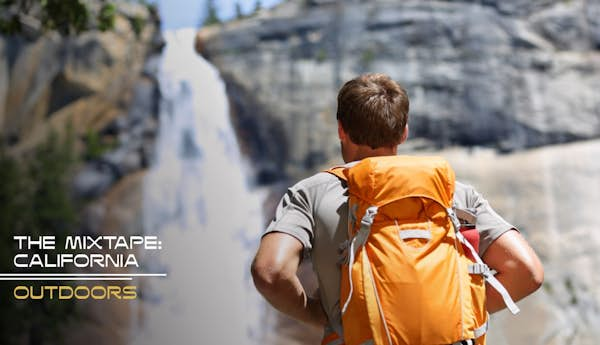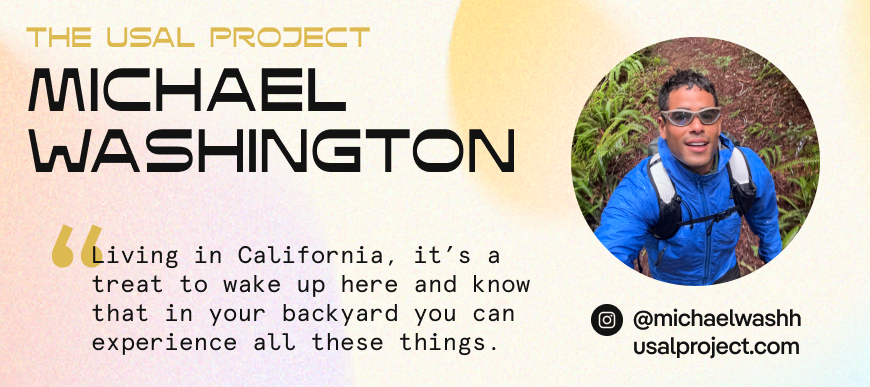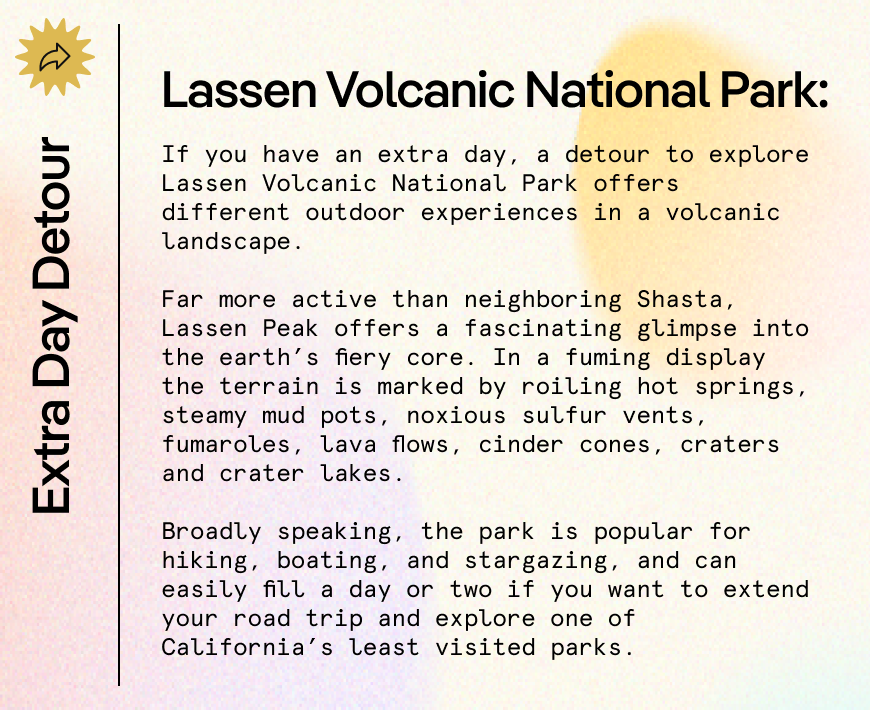It may be a cliche, but California is truly an outdoor playground. From the sun-kissed beaches of Southern California to the inland deserts and mountain slopes, to the rivers and Redwoods up north, there is no shortage of ways to escape the Golden State’s big cities, stretch your legs, and experience jaw-dropping scenery.
Because California is so big – more than 840 miles of coastline – a road trip is a great way to sample outdoor experiences in different parts of the state. To help plan the ultimate outdoor adventure in Northern California, we consulted Michael Washington. Michael is a Los Angeles based creator and entrepreneur who founded the USAL Project, which helps connect nature enthusiasts with the great outdoors.
Washington flew to San Francisco, rented a van, and hit the road north to explore some of the best camping spots and hike the trails among Redwoods along the Pacific Coast. With his input, here’s an itinerary packed full of outdoor adventures of every variety.
@ ♬ –

Escape the urban jungle
Setting out from San Francisco, you’ll cross the Golden Gate Bridge to begin your road trip – and the scenery will immediately begin to impress you as you make your way to the Pacific Coast along CA-1 (the Pacific Coast Highway). If you have time for an early detour, Muir Woods National Monument is one of the closest groves of Coastal Redwoods along the route – though there will be plenty of other opportunities to see these towering trees further north.

Following the coast northward, there are lots of photo opportunities and spots to stretch your legs. If hiking is what gets your heart pumping, spend a few hours at Point Reyes National Seashore. This peninsula juts into the Pacific where the San Andreas fault runs into the North American plate and has an otherworldly, windswept look – plus dozens of miles of trails to explore.
In addition to feeding your soul with natural beauty, there are some good stops for feeding your body, too: Washington suggests a personal favorite, Tomales Bay Oyster Co. “Once you order from their variety of oysters, you then take your goodies with you to a nearby beach to have a gorgeous oceanside picnic and shuck your own oysters by hand,” he says.

Mendocino Headlands State Park is another good spot to stretch your legs; take plenty of time to stop and see the jagged coastline and towering trees that punctuate the coast from here to the Oregon border. On the nearby Big River, you can rent and paddle an outrigger canoe up the estuary to see otters, birds, and even intrepid harbor seals fishing in the waterway.
For your first overnight stop, Humboldt Redwoods State Park is a good option.
“We camped at Burlington Campground which is perfectly situated between many of the amazing Redwood groves the park has to offer,” Washington says. “This area is called Avenue of the Giants; Founder’s Grove is one of the best hikes to do, as it is so close to the 101 and easy to get to.”

Forest bathing among giants
After fully exploring Humboldt Redwoods State Park hit the road again; there are a number of groves to stop and see on the drive north toward Crescent City. Most of these comprise Redwoods National and State Parks, and it’s really a matter of choosing how many times to stop and how many miles you want to hike among the centuries-old giants.

You can stay a night in Crescent City or opt to camp again at Jedidiah Smith Redwoods State Park (which is also part of the larger Redwoods National Park). Local companies offer kayak tours from the nearby town of Hiouchi that stop for a stroll among the trees.
From Crescent City turn northeast, heading inland along US-199. Meet up with Interstate 5, then turn southbound. (There are other, more time-consuming and less efficient mountain road options entirely in California, if you have an extra day or two.)

Exploring a volcanic landscape
As you travel down I-5, head for Mount Shasta, one of the southernmost volcanoes in the Cascade Range that runs up into Oregon, Washington, and British Columbia. There’s a small town nestled on the western slopes, also called Mount Shasta, which is a great overnight stop and home base for outdoor adventures in this area. You can camp here, or book one of the local hotels depending on how much you need some R&R by this point.
After a few days on the coastal cliffs and among the towering trees, the outdoor adventures near Mount Shasta offer nice diversity: explore lava tubes at Pluto’s Cave which formed during Shasta’s last eruption, about 3,200 years ago; go chasing waterfalls along the three-tiered McCloud Falls trail south of the mountain; or gain some elevation – and a beautiful perspective – by hiking to Heart Lake along the Pacific Crest Trail.
While the Pacific Coast is generally temperate year-round, you can also try snow sports on the slopes of Mount Shasta if you do this road trip during the winter months.

Back to the city
From Mount Shasta, the drive back to San Francisco is relatively straightforward: it follows I-5 down the Central Valley and then a series of interstates back to the city. There are fewer outdoor adventures along this route than at other points of the road trip, but the ones you can find here are unique.
A short detour in the Sacramento area provides options for white water rafting on the American River, or you could rent bikes and go cycling between wine tastings in Napa and Sonoma Counties. Hiking in the Berkeley Hills or Sibley Volcanic Nature Preserve near Oakland are both good urban adventure options. Then it’s back into the urban jungle to seek adventures there or in your next destination.
Other California Outdoors Experiences
There is no shortage of outdoor experiences in the Golden State; if your travel plans don’t take you to Northern California this time, head for these other regions:

Sierra Nevada: Unsurprisingly, this mountain range is a playground for nature lovers. The alpine Lake Tahoe is an excellent base for hiking and boating in the summer, or snow sports in the cooler months. Further south along the range, Yosemite National Park is essential; it’s one of the crown jewels of the National Park system and the site that inspired John Muir to begin preservation efforts.
The Southern High Sierras have special experiences too: like their northern, coastal brethren, the Giant Sequoias of Sequoia and Kings Canyon National Parks are humbling and impressive, and both parks offer plenty of ways to stretch your legs. On the eastern slopes, Mono Lake has long been a draw for visitors who want to admire the otherworldly formations in this saline soda lake.

Deserts: Further south, California’s desert region has a totally different set of experiences to offer: Death Valley National Park is full of incredible hikes and wild natural stone and salt formations, while Joshua Tree National Park beckons travelers with unique plants and trees, as well as incredible stargazing opportunities.

Central Coast: The Central Coast is also worth exploring if you want a full picture of California’s outdoor wonders. Washington suggests a camping road trip up (or down) the coast to enjoy tidepooling, hiking, and beachcombing at spots like Montana de Oro State Park, Spooner’s Cove, and Ragged Point; this could be an additional itinerary based out of Los Angeles, or part of a larger Pacific Coast Highway road trip, in conjunction with the route above.

The Mixtape: A road trip to the best urban experiences in California
The Mixtape: California brings diversity to the table
The Mixtape: Seeking inspiration in California’s mountains and deserts
The Mixtape: Kid-friendly destinations are a California specialty



